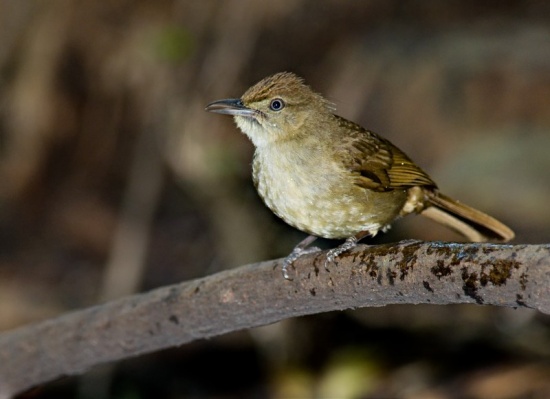- Iole propinqua
Identification
17-19 cm (6¾-7½ in). A slim, dull, small-headed bulbul, often showing a slightly frizzy crest.
- Olive-rufous crown to hindneck
- Smoky grey lores to above eye, upper face and ear-coverts
- Olive-brown mantle to rump
- Dark rufous-brown uppertail-coverts
- Olive-brown upperwing with a slight bronzy sheen
- Dark rufous-brown tail
- Dull white chin and throat with slightly elongated feathers
- Off-white mid-breast with some yellowish fringing
- Ashy olive-brown breast side and flanks, forming a distinctive patch
- Cream belly, tinged olive-brown
- Variable tawny-brown undertail-coverts
- Clear grey to white eye with contrasting blackish eyelid rim
Sexes similar.
Juveniles are duller than adults and have a light brown eye.
Variations
- aquilonis more yellow below (looking similar to subspecies myitkyinensis of Olive Bulbul)
- simulator has less green upperparts and much less yellow below (best told apart from Olive Bulbul by more olive wings, greyer supercilium and more rufescent undertail-coverts)
- innectens with dark olive green upperparts
- lekhakuni with brownish-olive upperparts and greyer underparts
- cinnamomeoventris without yellow tones on underparts
Distribution
Cambodia, China, Laos, Burma, Thailand, and Vietnam.
Locally fairly common. Probably often overlooked due to identification problems.
Taxonomy
Five subspecies recognized:
- I. p. myitkyinensis in northeastern and eastern Myanmar
- I. p. propinqua eastern Myanmar to southwest China, northern Thailand, northern Laos and northern Vietnam
- I. p. simulator from southeast Thailand to southern Laos, Cambodia and northern Vietnam
- I. p. aquilonis in southern China (southwest Guangxi) and northern Vietnam
- I. p. innectens in southern Vietnam
cinnamomeoventris and lekhakuni are now placed in Olive Bulbul, myitkyinensis was formerly placed in Olive Bulbul.
Habitat
Found in evergreen and mixed deciduous forest and forest edges. Also in secondary forest, often with major bamboo or vine component. Often around clearings and along roads, tracks and rivers.
Occurs from lowlands up to 1000 m, sometimes higher.
Behaviour
A relatively shy and unobtrusive species.
Diet
Feeds mainly on fruit and insects, but no detailed information. Usually foraging solitary or in pairs, sometimes in groups in canopy and middle storey.
Breeding
Breeds in April in northern Thailand. No other information.
Movements
Presumably a resident species.
References
- Clements, J. F., T. S. Schulenberg, M. J. Iliff, D. Roberson, T. A. Fredericks, B. L. Sullivan, and C. L. Wood. 2017. The eBird/Clements checklist of birds of the world: v2017, with updates to August 2017. Downloaded from http://www.birds.cornell.edu/clementschecklist/download/
- Del Hoyo, J, A Elliot, and D Christie, eds. 2005. Handbook of the Birds of the World. Volume 10: Cuckoo-Shrikes to Thrushes. Barcelona: Lynx Edicions. ISBN 978-8487334726
Recommended Citation
- BirdForum Opus contributors. (2024) Grey-eyed Bulbul. In: BirdForum, the forum for wild birds and birding. Retrieved 6 October 2024 from https://www.birdforum.net/opus/Grey-eyed_Bulbul




